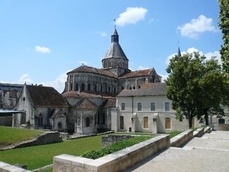
The priory, founded in 1059 by the powerful Order of Cluny, is the nucleus around which the town will develop. A major stopover on the roads to Santiago de Compostela and an obligatory crossing point on the Loire, the monastery grew rich and quickly played an essential role in the Cluny network. La Charité-sur-Loire became one of the five "eldest daughters of Cluny" and extended its influence over 45 priories and 400 dependencies. In the 12th century, the church of Notre-Dame was the second largest church in Christendom after Cluny, with more than 200 monks living in the buildings, which covered 3 hectares.
The Hundred Years' War, then the Wars of Religion, gradually weakened the city, a strategic place on the Loire between Burgundy and Berry. In 1559, a gigantic fire precipitated the ruin of the monastery, destroying the entire nave, a large part of the priory and the town.
Important works in the 17th and 18th centuries contributed to the rebirth of the town and the priory, the nave was rebuilt with 4 bays instead of the original 10 (important remains are visible on the façade of the Tourist Office, at the entrance to the church). After the Revolution, the priory, sold as a national asset, was integrated into the urban fabric. Some of the buildings were occupied by private individuals and shopkeepers. If the present nave dates from the end of the 17th century, the choir and the transept have kept the architectural elegance of the 11th and 12th centuries. The fame of the church of Notre-Dame is mainly due to the richness of its sculpted decoration, in particular remarkable series of capitals and pilasters, without forgetting two tympanums.
The first, the tympanum of the Virgin, is still in place at the foot of the Sainte-Croix bell tower. In 1840, the second one, the Transfiguration, was moved inside the church, for a better conservation. Prosper Mérimée, inspector of historical monuments, had the church of Notre-Dame classified, thus saving it from destruction since the initial route of the royal road from Paris to Nevers crossed the nave. Since 1998, it has been classified by UNESCO as a "world heritage site for humanity as part of the pilgrimage route to Santiago de Compostela in France" on the Vézelay route


